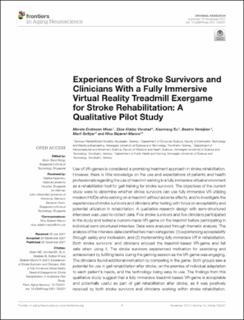| dc.contributor.author | Moan, Merete Endresen | |
| dc.contributor.author | Vonstad, Elise Klæbo | |
| dc.contributor.author | Su, Xiaomeng | |
| dc.contributor.author | Vereijken, Beatrix | |
| dc.contributor.author | Solbjør, Marit | |
| dc.contributor.author | Skjæret-Maroni, Nina | |
| dc.date.accessioned | 2022-03-18T09:37:42Z | |
| dc.date.available | 2022-03-18T09:37:42Z | |
| dc.date.created | 2021-12-02T16:17:09Z | |
| dc.date.issued | 2021 | |
| dc.identifier.issn | 1663-4365 | |
| dc.identifier.uri | https://hdl.handle.net/11250/2986111 | |
| dc.description.abstract | Use of VR-games is considered a promising treatment approach in stroke rehabilitation. However, there is little knowledge on the use and expectations of patients and health professionals regarding the use of treadmill walking in a fully immersive virtual environment as a rehabilitation tool for gait training for stroke survivors. The objectives of the current study were to determine whether stroke survivors can use fully immersive VR utilizing modern HMDs while walking on a treadmill without adverse effects, and to investigate the experiences of stroke survivors and clinicians after testing with focus on acceptability and potential utilization in rehabilitation. A qualitative research design with semi-structured interviews was used to collect data. Five stroke survivors and five clinicians participated in the study and tested a custom-made VR-game on the treadmill before participating in individual semi-structured interview. Data were analyzed through thematic analysis. The analysis of the interview data identified two main categories: (1) experiencing acceptability through safety and motivation, and (2) implementing fully immersive VR in rehabilitation. Both stroke survivors' and clinicians enjoyed the treadmill-based VR-game and felt safe when using it. The stroke survivors experienced motivation for exercising and achievement by fulfilling tasks during the gaming session as the VR-game was engaging. The clinicians found additional motivation by competing in the game. Both groups saw a potential for use in gait rehabilitation after stroke, on the premise of individual adaptation to each patient's needs, and the technology being easy to use. The findings from this qualitative study suggest that a fully immersive treadmill-based VR-game is acceptable and potentially useful as part of gait rehabilitation after stroke, as it was positively received by both stroke survivors and clinicians working within stroke rehabilitation. The participants reported that they experienced motivation in the game through safety, engagement and achievement. They also saw the potential of implementing such a setup in their own rehabilitation setting. Elements that enable safety and engaging experience are important to maintain when using a fully immersive VR-game in stroke rehabilitation. | en_US |
| dc.language.iso | eng | en_US |
| dc.publisher | Frontiers | en_US |
| dc.rights | Navngivelse 4.0 Internasjonal | * |
| dc.rights.uri | http://creativecommons.org/licenses/by/4.0/deed.no | * |
| dc.title | Experiences of Stroke Survivors and Clinicians With a Fully Immersive Virtual Reality Treadmill Exergame for Stroke Rehabilitation: A Qualitative Pilot Study | en_US |
| dc.type | Peer reviewed | en_US |
| dc.type | Journal article | en_US |
| dc.description.version | publishedVersion | en_US |
| dc.source.volume | 13 | en_US |
| dc.source.journal | Frontiers in Aging Neuroscience | en_US |
| dc.identifier.doi | 10.3389/fnagi.2021.735251 | |
| dc.identifier.cristin | 1963715 | |
| cristin.ispublished | true | |
| cristin.fulltext | original | |
| cristin.qualitycode | 1 | |

